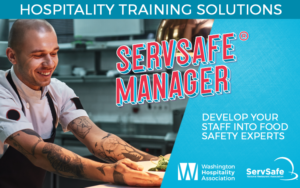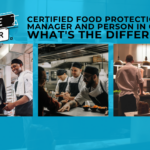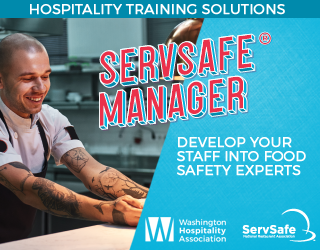By Lisa Leinberger, contributing writer
The last few months have been unprecedented for our industry. Whether you are a restaurant operator or a hotelier, a successful relaunch can get you back to what you do best: delivering local, personal hospitality experiences. While the industry may not look like it did before the coronavirus pandemic, your guests are very much looking forward to visiting your establishment, enjoying your food and drink and seeing all that Washington has to offer.
Along with these tips from professionals here in Washington state, you can also find reopening guidance from the National Restaurant Association and the American Hotel and Lodging Association.
Restaurant Operations guidance
Ken Batali, president of Batali Associates, recommends thinking about how you will staff your restaurant after restrictions are lifted. While this is a relaunch for many of us, Batali said this will be kind of like opening your restaurant for the first time.
“Talk to your crew now to make sure you know who is coming back,” he said. Some of them may have found other employment during the downtime. While there are still restrictions to maintain social distancing, think about the staff you will need.
You will need to retrain them. You will have new cleaning requirements for items that many people touch. If you have salt and pepper shakers on your tables, either make sure they are thoroughly cleaned between guests, or consider single-use packaging. If you offer a small box of teabags with your tea service, think about asking the customer what kind of tea they would like and bring them just that one bag with the service. This is the new reality for us as a community and your staff should know what your new procedures are.
Talk to your vendors now, especially the small ones, to make sure they have your inventory items you will need for a successful relaunch.
He recommends operators take a moment and assess their dining areas. Sit in your dining room, look around and assume a cross-contamination scenario. Use paper menus or chalkboards, instead of reusable menus.
“Our restaurants are going to need to be cleaned thoroughly,” Batali said. “Take the time to define new sanitation practices and document them.”
Once you get these new procedures down on paper, communicate and give them to your team in advance.
In order to maintain social distancing, if you have the ability, you may think of implementing reservations. Make sure chairs are six feet apart from other tables in your dining area. A reservation system can help you better manage the number of people in the dining room and keep guests from congregating in waiting areas.
If your restaurant has a patio dining area, get that ready to go on day one. Customers may feel more comfortable in an outside setting.
Lodging
While hotels have been deemed essential services and many remained open throughout the Stay Home, Stay Healthy Order, many of them have closed. Quentin Incao, CEO and hospitality guru at Q Hospitality Management, has many tips for reopening and running hotels post-pandemic. You can find his complete list at qhospitalitymanagement.com.
“The best thing that hotels can do at this time is plan. Make a plan and have it in place for when we reopen,” he said. “Do it now during this downtime so you can execute it and are not left scrambling.”
Incao said, communicate what you are doing to keep your guests and staff safe and healthy. Have a message in place and post it not only in your properties, but also on social media and your website.
Cleaning and sanitation of rooms will be very important, and Incao recommends using common sense. Assess the products you are using and determine which is the most effective. When you make decisions about how often your team switches out their gloves, consider and implement the recommendations from Labor and Industries and the Department of Health. There may be extra touch points throughout each room, such as door handles, door locks, lamp switches, drawer handles and buttons on safes. Don’t forget public-facing touchpoints such as elevator buttons.
“The end result is going to be a longer time in cleaning and that could be a good thing,” he said.
Consider how room keys and check-ins are handled. Do you want to use disposable keys? Could guests self-check-in using an app or a kiosk? Incao said there are plenty of apps that smaller hotels can use. Hoteliers should check with their property management system provider for ideas.
Think about placing sanitation stations in public areas with sanitizer.
Incao said he expects business to come back in the opposite way it left. First, the leisure and non-group travelers will come back.
“Everyone is ready to escape,” he said.
He expects large gatherings will take longer to recover. Based on what he sees and hears, conventions and significantly large groups may not come back until there is a vaccine in place.
Cleaning
Your restaurant may have been closed for a couple of months–it’s going to need some cleaning. Mike Haller, food safety technical manager from UL Everclean, said when restaurants are closed for any period of time, not only do you have to think about deep cleaning everything, but you also need to think about pests, such as rodents or cockroaches, who may have moved in during your downtime. Thoroughly check your restaurant for signs of this and take necessary action.
Haller recommends following the Centers for Disease Control and Prevention’s guidelines for cleaning solutions—make sure they are EPA-registered household disinfectants or use a solution of unscented bleach and water. The CDC recommends one-third cup of bleach per gallon of water.
Why unscented? “The scent takes the efficacy out of the product,” Haller said.
He also recommends turning on your water and letting it run for several minutes to reduce Legionella growth. The Washington state Department of Health has guidelines for this, and we have posted them on our coronavirus resources page.
Check your safety systems, such as your Ansul system or your fire extinguishers. You should check the date of inspection to make sure they are still valid. Make sure all of your food handlers’ cards are valid, too.
You should check your grease interceptors or traps—if they weren’t properly cleaned before your shutdown, they can get jammed up. Deep clean your refrigerators and make sure your ice machine is cleaned and sanitized.
He also recommended retraining your staff about your cleaning standards. Some of your staff may not return, and you will need to get them up to speed.
Mike Sperber, senior business development manager at UL Everclean, said that even if you are not a one of UL’s customers you can still reach out to them if you have questions. You can call 877-ULHELPS, or visit ul.com.
“We aim to be the Google of [sanitation questions],” Sperber said. “Our phones should always ring, whether you are a customer or not.”
Finance
Arnold Shain, concept development marketing and idea man at The Restaurant Group said conservative planning of your future sales is very important in our new normal.
He said to think about what your sales are going to be from now on. Will they be 35 or 50 percent of what you had before the stay-at-home order? Ask yourself what the timeline is to reach your goal.
You may want to take a look at your menu and decide what is selling the best and what you can cut. Shain said since to-go orders and delivery are the new normal, create some value-driven family-style or date-night meals. One of the restaurants he consults has seen great success with prime rib dinner boxes.
“This one has killed it,” he said of its success. Prime rib is something that not many people make at home: it is expensive and time-consuming. The kits included prime rib, potatoes and vegetables and rolls. Another restaurant created meals for Easter dinner. They started taking orders in advance a week and a half before Easter and ran out in six days.
Shain also suggested thinking about your beverage menu.
“I would do more value-driven specialty cocktails, just do a few,” he said. You can now deliver and sell cocktails as long as you sell them with a meal, they are in sealed containers and delivery drivers place them in the trunk or out of their reach.
The cost of doing business is something you need to plan. Business is down and bills are due. Now is the time to start renegotiating your rent with your landlord.
“Be transparent,” he said. When you renegotiate, send your landlord copies of your monthly operating statement, your balance sheet, personal bank statement and your monthly budget.
“They can see what kind of cash you have,” he said. Landlords don’t want to have to find new tenants for your space during these uncertain times and you don’t want to leave.
Also, think about your staffing. Labor is the largest piece of your budget. Make sure you have the right people in place to ensure proper customer service.
Zero-cost marketing
As you are stepping into your new business model, over-communicating to your customers will be key.
The time to start beefing up your social media presence is during this downtime. You should post regularly, whether that is pictures from your restaurant before the pandemic, recipes, photos of popular menu items or just interacting with your customers. If you have been offering take-out and delivery during the Stay Home, Stay Healthy Order, you should post your new menus to let your customers know what you are still making from your regular menu and special family-style meal kits.
Deba Wegner, owner of Recipe for Success Inc., a public relations and marketing firm for restaurants, also has some advice for those looking for zero-cost marketing ideas.
“It’s not going to be going back to what we had before,” she said. She said you should review your marketing strategies you had in place before this crisis and decide if that will still work for you now. Keep your website up to date with the latest menus and contact information. Email your regulars. Update all your social media channels.
“Otherwise people won’t know that [you’re] open,” she said.
Your messaging also needs to be up outside of your restaurant. Place A-boards outside, along with banners and posters.
“We have to promote it like we would if this was the normal way of making money,” she said. Get signage that looks enticing, along with your packaging. She notes there is a cost to that, and that should be built into your budget going forward.
Like Shain, Wegner said meal kits are a great addition to your menus. One Mexican restaurant she consults offered Cinco de Mayo kits: margarita kits, chips and salsa and enough tacos for a family. She suggests keeping these meal kits to family-sized, since we don’t want to give the impression that we are condoning large get-togethers.
Slip paper menus inside your to-go and delivery orders. Offer bounce-back cards. Reward your customers for coming back.
“We want to make sure people re-order,” she said.
Make sure someone is answering the phone at the restaurant. This person must be well-versed in the menu and suggestive selling.
Have a basic message and keep it consistent on all channels: email, social media, website and over the phone.
Wegner said one of the most important tips is to get back to basics. Review your customer service practices with your staff. When someone enters your restaurant, make sure your staff says, “Welcome back.”
She notes that not only have our hospitality businesses been in crisis, but so have our guests and they are out looking for the comfort that comes from going to a restaurant.
“We have to be the positive force,” she said. While guests will be forgiving during these uncertain times, she doesn’t think they will forgive poor customer service.
















![[Class, May 20] ServSafe Manager, Kent](https://wahospitality.org/wp-content/uploads/2018/07/CALEND1-150x150.png)








